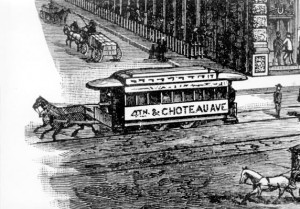Erastus Wells: The Father of St. Louis Mass Transit – and of Wellston
Erastus Wells, the entrepreneur who gave the area the boost it needed to become a developed area, was well known as the father of public transportation in St. Louis.
Born on December 2, 1822, in Jefferson County, New York, Wells came to St. Louis in September 1843 intent on seeking his fortune. He quickly formed a partnership with Calvin Case, and together they built the first omnibus line west of the Mississippi River.
The authors of Mound City on the Mississippi note:
The horse-drawn car ran from Third and Market Streets to the north side ferry landing at Madison Street. After just five years of operation, Wells and four competitors had 17 omnibuses that went on 200 daily rides, carrying 3,840 people at 5¢ a ride. Total profit from all the omnibus routes was $67,000. Wells, along with Calvin Case and other entrepreneurs, bought out all the competition, giving him the first citywide transit monopoly. Case and Company grew to 90 buses and 450 horses and eventually included a short line to Belleville.
Their company prospered, but after Case died, Wells sold the company for a “considerable sum of money.”
In 1859, Wells was granted a charter for St. Louis’s first street railway company which ran horse-drawn streetcars or “herdics.” On July 4 of that year, note the authors of Mound City, “the City´s first streetcar, called a ‘street railroad,’ was partially completed along Olive Street. Erasmus Wells, the president of the Missouri Railroad Company, made the first run.”
This car loaded with company representatives as well as city officials drew a large cheering crowd, but rocks along the tracks derailed the car on its maiden run. Company engineers devised a way to eliminate this problem and soon the street car business overtook the omnibus (which was a large stage couch) method of local travel. The main advantages of using a horse drawn street car on rails versus the horse drawn omnibus was the increased passenger capacity and a much smoother ride.
Establishing himself as president of the Missouri Railway Company, Wells built the first street railway west of the Mississippi River. He later developed the Narrow Gauge Railway, which stretched from St. Louis (from near Grand and Olive) to Normandy and, in 1878, to Florissant. The railway system had a substation at what later became Wellston.
Wells also served as director of Ohio and Mississippi Railroad, president of Accommodation Bank, and vice president and director of Commercial Bank. In 1848, he was elected to the city council of St. Louis and, after a brief absence, was elected to the council again in 1854 and served until 1869. Wells was elected to the United States Congress in 1868 and served as a representative from 1869 to 1877.
Wells continued his entrepreneurial efforts, obtaining the first substantial appropriation for the improvement of the Mississippi River and, in 1879, leading St. Louis citizens in gaining control of the Laclede Gas Light Company, of which he later became president.
Next.
